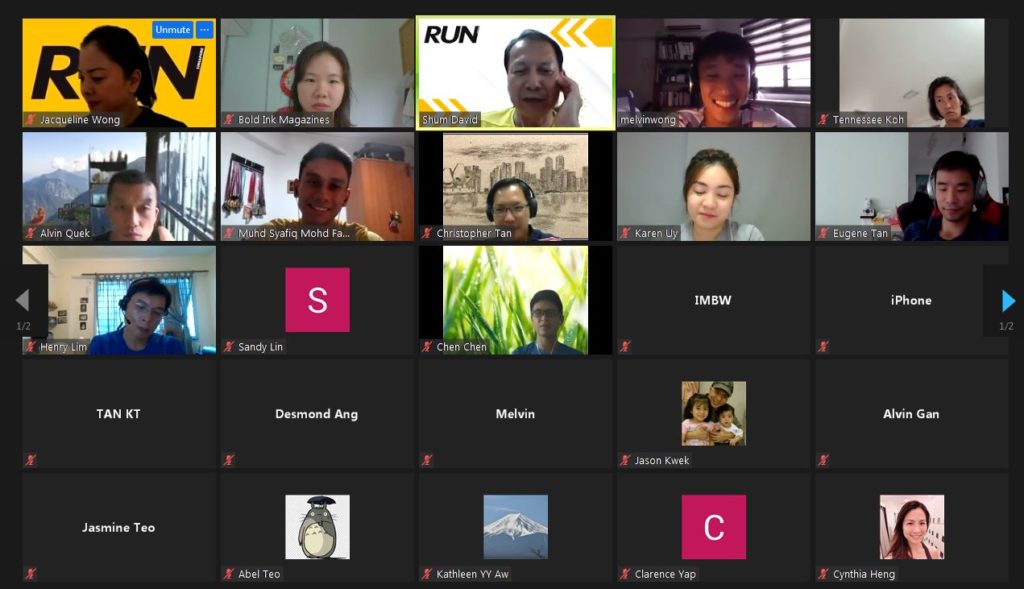During our second session of Inside the DM Talk, David Shum (Community Lead Coach, Sports Therapist) and Melvin Wong (Former Team SG Athlete SEAG 2015) discussed how one should chart their training and what factors they should take in consideration. They also answered questions from our sign-up form and from the floor.
There is no one pill that fits all. David recommends starting from backwards- what is your end goal? When is the race you want to run? From there, what is it you want to achieve? Is it to hit your personal best? Do you have other commitments you have to juggle with in the meantime? Do you have any injuries or otherwise? After all, David emphasizes that we are full time workers and part-time runners. Not many of us would be privileged enough to be full time runners.

Frequency, volume, intensity are the three pillars of a training regime. Depending on when the race is, one has to work backwards to determine time and duration. For instance, when do you want to start training? Based on these three pillars, one can do interval, hill, LSD (Long Steady Distance) runs. You should not overload or over train, do watch your reaction to training.
In charting a training program, David typically has people do a general preparation, some core training then specific training and in the last month, race specific training. For the training, he toggles between volume and intensity. At Safra where he is a coach, the frequency is set at 3 times a week. If there is a day with high volume, then the next training will have lower intensity.
Assuming there is 12 weeks left to a half marathon, David will break it down into 3:6:3- 3 weeks of general preparation, 6 weeks more on volume and 3 weeks of race mode such as time trial. This time trial would take place in the first of third weeks and would not be the full distance but more of 10 km to solve any teething issues and to give one a mental edge. For the 6 weeks, David would focus on volume. So high interval workouts, tempos of 10 km and LSDs. He would not look at intensity but some intermediate runners would want to touch on that.
Each one of us has a different way to approach training, what’s important is to note our current capabilities and to chart out our ideal performance. Of course, reality will come into play but it’s good to have something to work towards.
How do you chart your progress in this period when there are no races?

David recommends to note your current status- if you have any strains or injuries. If you do, chart your training around these constraints. If you’re completely healthy, you might want to go for a time trial and from there, you want to see if you want to either load up your training or maintain your current schedule. There are also virtual races, you can sign up for those for something to commit to and work towards.
On the other hand, Melvin thinks it’s a good idea to determine the segment of the training block you’re crafting for yourself and find a measure to monitor the success of your training. For instance, you could want to be in good shape for 5 km or 10 km. Your training block could be 4 weeks or 6 weeks. After this training block, you can do a time trial of maybe 8 km if you’re working towards a 10 km run and note your pace, effort, what’s the outcome (time, heart rate). Essentially, you access your training based on your outcome.
How does one maintain mileage during this period? Does one do more short runs with higher frequency?
David thinks it boils down to frequency, volume and intensity. He thinks that doing frequent short runs will help you build up to being able to do longer runs. However, if it is your goal to do longer runs, he suggests tweaking the frequency and upping the intensity.
Melvin would base his training around his lifestyle and during this period. He would stick to a run a day and a short core training if he can squeeze it in. He encourages everyone to take a look at their athletic goals versus your lifestyle and what you can afford to come up with a middle line. It’s hard to strike a balance because it goes up and down but it’s good if you can find a sweet spot.
Sharing sessions from the floor:
Syafiq talked about juggling training in the period of Ramadan. He has toned down his intensity and tweaks his workout based on how he feels- if he feels good, he will up it, if not, he will just maintain. He mentioned training just before his pre-dawn meal and before breaking fast. Essentially, Syafiq’s sharing was about working around your current schedule and limitations and finding a schedule that works for you.

Christopher shared about his story from charting a Standard Chartered Marathon in 4:30 then to flab and how he’s getting his fitness back. His push factors are to get his fitness back and to look good, feel good. He emphasizes that you have to do the first push-up. He does HIIT and eats less now. For weekends, he ups the intensity and also pushes himself more.
Tennessee is a working mom. Her day starts early in the morning. She does the housework, tends to her kid’s meals, does strength and resistance training, takes a shower then starts work. Most of the time, she does her runs at 12pm because that’s her only free time. She tries to run every day but is taking it easy these days due to a strain. She loves the sun, so afternoon runs are not a problem for her.
Henry is a Singapore Masters runner in sprint and throws events. He came from a triathlon background for 10 years then went back into athletics in the last 5 years. 100s, 200s, 400s and also shotput and javelin. He went hard on intensity when he was younger, which resulted in injuries such as shin splints. He manages this by going with 70% intensity in his training rather than going full out. He also does yoga. His transition from long duration runs to sprints was not easy but as he mentions, it’s about the trade offs.
Is high mileage the key to better timings? (For instance, 80km and 140km to get a 3 hours timing at marathons)
David mentions running efficiency and support points- does one have adequate hydration planned? Aerobic power would be needed for these events. You would also have to take in consideration what event you are training for. If you’re training for 10 km, 21 km or the full marathon 42 km, 80 km would be a lot and 140 km might be too much. It goes back to how you want to improve your endurance, aerobic fitness and more importantly, to avoid injury.

Melvin shared about being a triathlete for 7 years. Swimming is a technical sport and he struggled with it because he came into sports after finishing the army. He then shared a sport of a Australian athlete who trained to compete at the Olympic level for triathlons by swimming 60 km a week. There is an element of truth of having the duration of training. Melvin thinks there has to be a duration to training but not necessarily mileage.
For instance, people would take different timings to finish 100 km. Essentially, Melvin emphasized that it’s about how many hours you put into training each week. He also shared another story of his two marathons 2:41 timing 2 years apart. The first was done with short long runs, 24-28 km runs at a fast pace. For the second program, he did training with bigger volume and less intensity. There is no one clear golden rule that running 100km or more will give you a timing of 3 hours at a marathon.
“The key point here that I learnt over the years is that we need to be realistic and practical about our bodies,” Melvin highlighted. His mileage is 100-120 km a week because it’s what his body can handle and what his lifestyle and other commitments can accommodate.
How much time do you take off before you have to reevaluate your training?
David will go back to frequency, volume and intensity. He will spend more time on intervals and tempo if it’s a 10 km distance. His advice is to adjust the frequency, volume and intensity based on your goals and what you want to achieve and work around it accordingly.
As for Melvin, 3 days is a threshold and limit to not training, when he would start to feel running to be a bit foreign and something his body needs to readjust again. His suggestion is that when you take three days or more off, to start off small or slow such as doing a walk or jog to reintroduce the notion of running to the body again. Take two days to walk and then a walk-jog then a low intensity run over 2 days. After doing so for 4-5 days, work it up to a run.
He shared his experience of having a virus attack after the Gold Coast Marathon where he was bed-ridden for 10 days. The only movement he did was to the toilet during that time. He could only walk 5 minutes out of the door and back after the worst has passed. “Take baby steps to condition your body,” he said and that it is a very smart tool that will accept the conditioning.

Through these sessions, David and Melvin hope to share their experience and expertise to help runners not make the same mistakes and to help them reduce the time taken to reach their goals. Join our sessions for the full insights. Our next session is on “Tracking Progress and Injury Management”, more information to be released soon.






Comment (0)